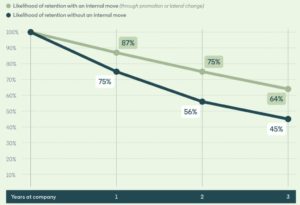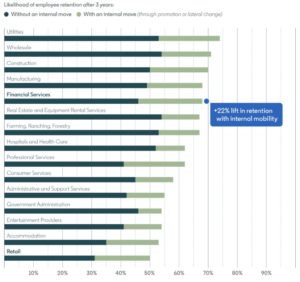Previous segments of this blog series touched on the disconnect between workers and employers, the shifting priorities and values of the general workforce and the role management and leadership plays in DEI initiatives. In this final installment, we dive into what it will take for savvy companies to position themselves for success.
With most businesses expected to increase their headcount in the near term, there is a massive opportunity to influence and improve the workforce of the future. Inclusive leadership more crucial than ever for a company to grow and thrive. Inclusive leaders bring out the best in their employees, resulting in a culture that fosters collaboration, creativity and innovation. Companies that draw on a wealth of perspectives in their leadership and teams will have the advantage in creating new ways of working, as well as new products, services and business models. Those that don’t promote accountability, lack needed resources for employee education and development, or fail to incorporate inclusion into their mission, vision and values, will fall to the wayside.
The effectiveness of leaders and managers is a priority for 60 percent of HR leaders heading into 2023, with a quarter of respondents saying their leadership development approach does not prepare managers for the future of work. To be successful, today’s business leaders must take a human-centric approach; in other words, leading with authenticity, empathy and adaptivity.
Along with inclusion comes the notion of support. A report by the Tandym Group found that professionals ranked support from leadership/management as the most important element of company culture. But this goes beyond making employees feel valued and respected as an individual. It entails real dedication to, and investment in, employees’ professional development. Alarmingly, 44 percent of HR leaders believe their organizations do not have compelling career paths, making employee experience another priority for next year.

LEARN TO LOVE LEARNING
Supporting employees’ professional development and education is one of the most impactful ways to make a difference—and that’s not just an opinion. A Better Buys survey discovered employees who have such prospects are 15 percent more engaged with 34 percent higher retention. Meanwhile, Deloitte discovered that businesses that emphasize learning are 92 percent more likely to develop innovative products and processes, and are 52 percent more productive, 56 percent more likely to introduce new products and services to the market and are 17 percent more profitable than their counterparts. Further, their engagement and retention rates are also 30 percent to 50 percent higher.
Workers have certainly taken notice. LinkedIn’s August 2022 Talent Drivers survey showed that while the top three factors for employees seeking work are compensation, work-life balance and flexibility, the opportunity to learn new, highly desired skills and opportunities for career growth within the company round out the top five priorities.
A whopping 86 percent of professionals polled by Tandym said they’d switch jobs for more development opportunities. Nearly 9 in 10 executives are experiencing skills gaps in the workforce or expect to experience them within the next few years, and about half of US workers say they will have to learn new skills in the next few years to do their job.
Interestingly, half of employees polled do not feel their company is helping them learn new skills for the future, even though 52 percent of employers revealed plans to expand their training and educational offerings this year. If current labor dynamics continue, businesses who fail to incorporate education and development are being set up for failure. Providing learning and development not only builds loyalty, but also ensures the company has the skills it needs to be competitive and relevant.
In other words, bosses need to know what they’re working with, and endeavor to shore up areas that are lacking. This requires leadership to be involved and engaged with staffers of all ranks. Across the 15 industries in its study, LinkedIn found that employees who make an internal move are more likely to stay at their organization longer than those who stay in the same role.
Prioritizing employees’ professional development isn’t a monumental task, but it does take effort by leadership to make personal connections with employees. Career development experts outline three ways organizations can make learning and development a priority. The first is to establish learning opportunities and engagement early and keep going at a steady pace—starting at the onboarding process and continuing through employees’ tenure at the company.
Professional education should also be engrained into a company’s structure and process beyond simply being an HR function, establishing it as a normal part of the workday, or week, or month. Ritualizing learning helps employees feel a sense of belonging and a connection to purpose, leading to higher engagement and performance.
Finally, firms should provide coaching and mentorship to more than just the highest-ranking executives. As per Deloitte, “A coaching culture is the practice that’s most highly correlated with business performance, employee engagement, and overall retention. While directed management is important, it plays a smaller role than one might think. It is the coaching and development role of management that is the most valuable.”

Showing all your employees that they’re worth investing in will go much farther than focusing on a small handful who are already close to the top of the ladder. In addition to one-on-one relationships, companies can also utilize advancements in technology and communications to provide a broader swatch of opportunities for staffers.
When organizations make employee development a priority, workers will inherently follow suit. Companies that will thrive in the coming years will be the ones who establish professional growth as not just a priority, but as a key component of the organization’s mission, values and goals.




